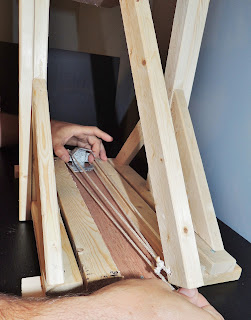Rules for Bean Bag Fling
Design Requirements/Specifications
Trebuchets, slings and beanbags must be made by the Trailmen and not store
bought.
The maximum height of any trebuchet, including swing arm in
the vertical position with release pin, is 3 feet.
The maximum length of the base of the trebuchet is 18 inches
The maximum width of the base of the trebuchet is 12 inches.
Competition Specifications
A minimum of three types of competitions are held - Accuracy, Distance and Best Design
Award categories must include, but are not limited to, “Most Accurate”, “Longest Shot”, and “Best Design”.
Accuracy Competition
The firing targets will consist of 5 rings.
The rings will get progressively smaller
(like skeet ball) and the point value increase moving inward toward the center
.
The outer ring will be worth 5 points, moving inward, the fourth is 10, third is 15
second is 20 and the center is 25.
Maximum score per round is 50 and maximum score per competition is
150.
To begin the competition, the middle of the firing target
ring will be placed at a distance of 25 feet from the firing line.
Each trailman is allowed 2 shots from each of 3 different
distances.
After each competitor has taken his two shots at that distance, the target is then moved to the next distance.
Shots 1&2 will be shot from a distance of 25 feet
Shots 3&4 will be shot from a distance of 35 feet
Shots 4&5 will be shot from a distance of 45 feet
After each Trailman has completed 6 shots the scores from
each shot will be added together and the highest score will win the accuracy
competition.
In the event of a tie for highest score, the target will be moved out an additional 5 feet, to 30 feet,
and two additional shots will be taken by tying
competitions
.
The distance will be set
at 30 feet and the highest combined score will determine the winner.
If yet another tie occurs, follow the same procedure with the target at a distance of 40' and then 50' if a third tie occurs.
Distance Competition
Each Trailman will get 2 shots with only the
furthest shot being counted. The
longest shot wins.
Voting for Best Desgin
Before the accuracy and length competitions begin, have all competitors place their trebuchets in a protected (adult monitored/no touching) area. Provide ballots and a ballot box. Each Trailmen is allowed only one vote and the votes remain anonymous. This needs to be done far enough in advance so as not to delay the beginning of the other competitions. During the other competitions, have two adults count and double count the votes saving the winner's name to be announced at the Award's Ceremony at the end of the day.
This category could be expanded to include subdivisions such as "Best Use of Color", "Most Realistic", "I'd Pay Money for That", etc...to keep it fun and allow for more winners. You would simply provide each Trailman with a ballot for each category as well as a separate box for each of the different categories.
























































